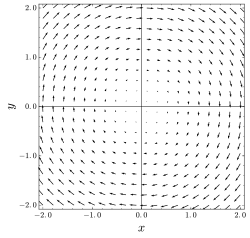Solenoidal vector field

In vector calculus a solenoidal vector field (also known as an incompressible vector field, a divergence-free vector field, or a transverse vector field) is a vector field v with divergence zero at all points in the field: A common way of expressing this property is to say that the field has no sources or sinks.[note 1]
Properties
[edit]The divergence theorem gives an equivalent integral definition of a solenoidal field; namely that for any closed surface, the net total flux through the surface must be zero:
where is the outward normal to each surface element.
The fundamental theorem of vector calculus states that any vector field can be expressed as the sum of an irrotational and a solenoidal field. The condition of zero divergence is satisfied whenever a vector field v has only a vector potential component, because the definition of the vector potential A as: automatically results in the identity (as can be shown, for example, using Cartesian coordinates): The converse also holds: for any solenoidal v there exists a vector potential A such that (Strictly speaking, this holds subject to certain technical conditions on v, see Helmholtz decomposition.)
Etymology
[edit]Solenoidal has its origin in the Greek word for solenoid, which is σωληνοειδές (sōlēnoeidēs) meaning pipe-shaped, from σωλην (sōlēn) or pipe.
Examples
[edit]- The magnetic field B (see Gauss's law for magnetism)
- The velocity field of an incompressible fluid flow
- The vorticity field
- The electric field E in neutral regions ();
- The current density J where the charge density is unvarying, .
- The magnetic vector potential A in Coulomb gauge
See also
[edit]Notes
[edit]- ^ This statement does not mean that the field lines of a solenoidal field must be closed, neither that they cannot begin or end. For a detailed discussion of the subject, see J. Slepian: "Lines of Force in Electric and Magnetic Fields", American Journal of Physics, vol. 19, pp. 87-90, 1951, and L. Zilberti: "The Misconception of Closed Magnetic Flux Lines", IEEE Magnetics Letters, vol. 8, art. 1306005, 2017.









